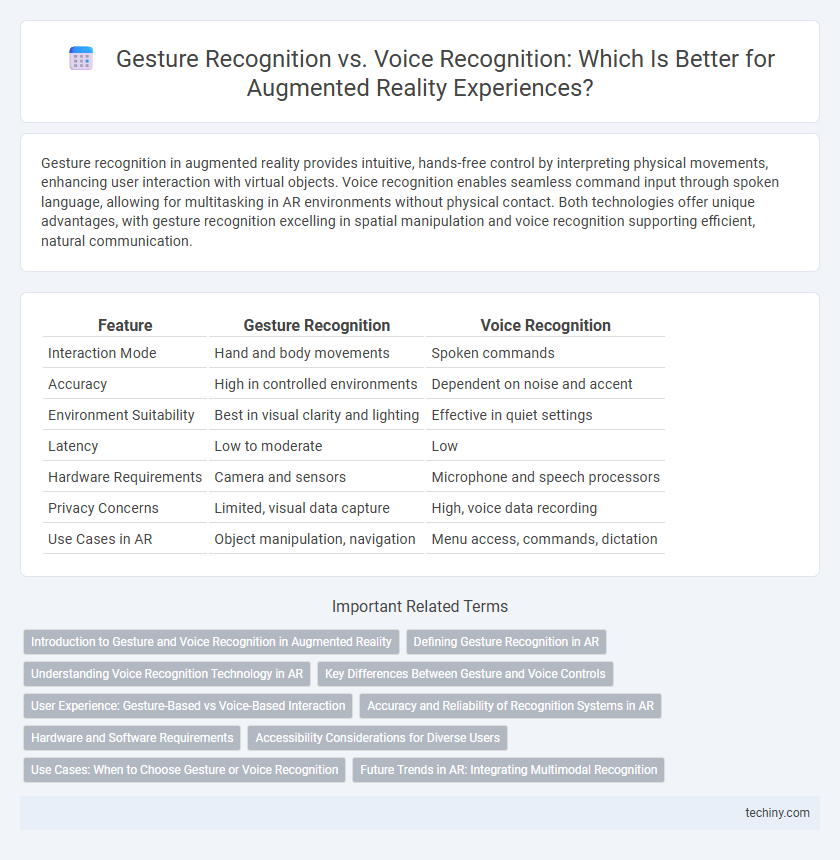Gesture recognition in augmented reality provides intuitive, hands-free control by interpreting physical movements, enhancing user interaction with virtual objects. Voice recognition enables seamless command input through spoken language, allowing for multitasking in AR environments without physical contact. Both technologies offer unique advantages, with gesture recognition excelling in spatial manipulation and voice recognition supporting efficient, natural communication.
Table of Comparison
| Feature | Gesture Recognition | Voice Recognition |
|---|---|---|
| Interaction Mode | Hand and body movements | Spoken commands |
| Accuracy | High in controlled environments | Dependent on noise and accent |
| Environment Suitability | Best in visual clarity and lighting | Effective in quiet settings |
| Latency | Low to moderate | Low |
| Hardware Requirements | Camera and sensors | Microphone and speech processors |
| Privacy Concerns | Limited, visual data capture | High, voice data recording |
| Use Cases in AR | Object manipulation, navigation | Menu access, commands, dictation |
Introduction to Gesture and Voice Recognition in Augmented Reality
Gesture recognition in augmented reality leverages sensors and computer vision algorithms to accurately interpret user hand movements and finger positions, enabling intuitive and immersive interactions without physical controllers. Voice recognition utilizes advanced natural language processing models and microphones to capture and decode spoken commands, allowing hands-free control and seamless communication with AR environments. Both technologies enhance user experience by providing distinct input methods that cater to different interaction needs within augmented reality applications.
Defining Gesture Recognition in AR
Gesture recognition in augmented reality (AR) involves the system's ability to interpret human hand and body movements as input commands, enabling users to interact with virtual elements seamlessly. This technology leverages sensors, cameras, and machine learning algorithms to detect and translate gestures into real-time actions within the AR environment. Gesture recognition enhances immersive experiences by providing intuitive, touchless control that complements or replaces traditional voice recognition methods.
Understanding Voice Recognition Technology in AR
Voice recognition technology in augmented reality (AR) utilizes advanced natural language processing (NLP) algorithms and deep learning models to interpret user commands accurately, enabling hands-free interaction with AR environments. This technology processes vocal inputs through microphones integrated into AR devices, converting speech into actionable data that enhances user immersion and accessibility. Precision in understanding context, accents, and ambient noise is critical for optimizing voice recognition performance, making it a robust interface option compared to gesture recognition in AR applications.
Key Differences Between Gesture and Voice Controls
Gesture recognition in augmented reality relies on visual detection of hand movements and body language to interact with digital elements, offering intuitive spatial control. Voice recognition uses speech inputs, enabling hands-free commands and natural language processing for user interaction. Key differences include responsiveness to environmental factors--gesture recognition requires clear visibility and lighting, while voice recognition depends on accurate audio capture and noise reduction.
User Experience: Gesture-Based vs Voice-Based Interaction
Gesture recognition in augmented reality offers intuitive, hands-free control that enhances spatial immersion and precision, allowing users to interact naturally with digital elements in their environment. Voice recognition provides convenient, hands-free commands but can struggle with accuracy in noisy settings or with diverse accents, potentially disrupting user flow. Combining gesture and voice recognition delivers a more versatile AR experience, accommodating various user preferences and contexts for seamless interaction.
Accuracy and Reliability of Recognition Systems in AR
Gesture recognition in augmented reality offers high precision in tracking complex hand movements, enabling intuitive control with minimal environmental interference. Voice recognition systems provide convenience but often face challenges in noisy environments, reducing accuracy and reliability during AR interactions. Combining both modalities can enhance overall system robustness by leveraging the strengths of gesture-based input and voice commands in diverse AR settings.
Hardware and Software Requirements
Gesture recognition in augmented reality relies on advanced hardware such as depth cameras, infrared sensors, and motion trackers to accurately capture hand and body movements, while software requires sophisticated machine learning algorithms for real-time gesture interpretation and spatial mapping. Voice recognition demands high-quality microphones, noise-cancellation technology, and often edge computing devices to process audio inputs, paired with natural language processing (NLP) software rigorously trained on diverse linguistic datasets to ensure accurate command detection in noisy environments. Hardware for gesture recognition tends to be more sensor-intensive and reliant on visual data capture, whereas voice recognition hardware focuses on auditory input fidelity, with both requiring tailored software solutions optimized for latency, accuracy, and environmental conditions.
Accessibility Considerations for Diverse Users
Gesture recognition in augmented reality offers intuitive control for users with speech impairments or in noisy environments, enhancing accessibility by relying on physical movements that can be customized for individual needs. Voice recognition provides hands-free interaction beneficial for users with limited mobility or visual impairments, leveraging natural language processing to interpret diverse speech patterns and accents. Combining both input methods creates a more inclusive AR experience, accommodating diverse user abilities and environmental contexts.
Use Cases: When to Choose Gesture or Voice Recognition
Gesture recognition excels in environments requiring hands-free interaction without noise interference, such as manufacturing floors or surgical rooms, where precise and discreet commands enhance efficiency. Voice recognition suits scenarios demanding natural language input, like smart home control or navigation in vehicles, enabling intuitive user experiences even while multitasking. Selecting between the two depends on factors like ambient noise levels, user mobility, and the complexity of commands in augmented reality applications.
Future Trends in AR: Integrating Multimodal Recognition
Future trends in augmented reality emphasize the integration of multimodal recognition, combining gesture recognition and voice recognition for enhanced user interaction. Advances in machine learning and sensor technology enable seamless fusion of hand gestures and vocal commands, improving accuracy and contextual understanding within AR environments. This multimodal approach facilitates more natural, intuitive interfaces, driving innovation in AR applications across gaming, healthcare, and industrial sectors.
Gesture Recognition vs Voice Recognition Infographic

 techiny.com
techiny.com